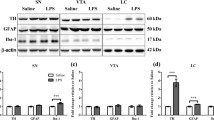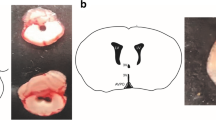Many studies are currently addressing the involvement of orexin-containing hypothalamic neurons in the responses of the CNS to administration of antigens, particularly lipopolysaccharide (LPS). The dynamics of changes in the number of orexin-containing neurons in hypothalamic structures in brain slices were assessed 2, 4, and 6 h after administration of LPS at a low, non-septic dose. Comparative analysis of the responses of orexin-containing neurons after administration of a non-septic and a higher, subseptic, dose of LPS was performed. LPS at a dose of 25 μg/kg was followed 2 and 4 h later by increases in the numbers of orexin-positive neurons, with subsequent decreases in numbers, while the higher LPS dose of 500 μg/kg altered the neuron count only at 6 h, with a more significant decline in the number of orexin-containing neurons. These data provide evidence for changes in the content of orexin detected within neurons and a change in the balance of orexin synthesis and utilization processes in response to administration of an antigen.
Similar content being viewed by others
References
Yu. V. Gavrilov, S. V. Perekrest, and N. S. Novikova, “Expression of c-Fos protein in cells in various structures of the hypothalamus in electrical pain stimulation and administration of antigens,” Ros. Fiziol. Zh. im. I. M. Sechenova, 92, No. 10, 1195–1203 (2006).
E. A. Korneva and L. M. Khai, “Effects of lesioning of parts of the hypothalamic area on the process of immunogenesis,” Fiziol. Zh. SSSR, 49, No. 1, 42–48 (1963).
V. A. Lesnikov, “Neurohumoral mechanisms of regulation of the functions of the red bone marrow as a source of hematopoietic stem cells,” in: Immunophysiology [in Russian], E. A. Korneva (ed.), Nauka, St. Petersburg (1993), pp. 294–315.
S. V. Perekrest,Yu. V. Gavrilov, T. V. Abramova, N. S. Novikova, and E. A. Korneva, “Activation of cells in hypothalamic structures on administration of different types of antigen (in terms of c-fos gene expression),” Med. Immunol., 8, No. 5–6, 631–636 (2006).
S. Baatout, “Interleukin-6 and megakaryocytopoiesis: an update,” Ann. Hematol., 73, 157–162 (1996).
C. Becskei, H. Riediger, D. Hernadfalvy, A. Arsenijevic, T. A. Lutz, and W. Langhans, “Inhibitory effects of lipopolysaccharide on hypothalamic nuclei implicated in the control of food intake,” Brain Behav. Immunol., 22, No. 1, 56–64 (2008).
C. T. Beckmann and M. Yanagisawa, “Orexin: from neuropeptides to energy homeostasis and sleep/wake regulation,” J. Mol. Med., 80, 329–342 (2004).
M. G. Dube, S. P. Kalra, and P. S. Kalra, “Food intake elicited by central administration of orexins/hypocretins: identification of hypothalamic sites of action,” Brain Res., 842, 473–477 (1999).
J. K. Elmquist and C. B. Saper, “Activation of neurons projecting to the paraventricular hypothalamic nucleus by intravenous lipopolysaccharide,” J. Comp. Neurol., 374, No. 3, 315–331 (1996).
R. A. Espana, B. A. Baldo, A. E. Kelley, and C. W. Berridge, “Wakepromoting and sleep-suppressing actions of hypocretin (orexin): basal forebrain sites of action,” Neurosci., 106, No. 4, 699–715 (2001).
R. P. Gaykema, S. M. Park, C. R. McKibbin, and L. E. Goehler, “Lipopolysaccharide suppresses activation of the tuberomammillary histaminergic system concomitant with behavior: a novel target of immune-sensory pathways,” Neurosci., 152, No. 1, 273–287 (2008).
R. P. A. Gaykema, L. E. Goehler, C. B. Armstrong, J. Khorsand, S. F. Maier, and L. R. Watkins, “Differential FOS expression rat brain induced by lipopolysaccharide and staphylococcal enterotoxin B,” Neuroimmunomodul., 6, 220 (1999).
L. E. Goehler, R. P. A. Gaykema, and K. Hansen, “Staphylococcal enterotoxin B induces fever, brain c-Fos expression, and scrum corticosterone in rats,” Am. J. Regul. Integ. Comp. Physiol., 280, R1434–R1439 (2001).
G. J. Hervieu, J. E. Cludery, D. C. Harrison, J. C. Roberts, and R. A. Leslie, “Gene expression and protein distribution of the orexin-1 receptor in the rat brain and spinal cord,” Neurosci., 103, 777–797 (2001).
T. Ida, K. Nakahara, T. Katayama, N. Murakami, and M. Kakazato, “Effect of lateral cerebro-ventricular injection of the appetite-stimulating neuropeptide, orexin and neuropeptide Y, on the various behavioral activities of rats,” Brain Res., 821, 526–529 (1999).
T. Ida, K. Nakahara, T. Murakami, R. Hanada, M. Nakazato, and N. Murakami, “Possible involvement of orexin in the stress reaction in rats,” Biochem. Biophys. Res. Commun., 270, 318–323 (2000).
M. Kopf, L. LeGros, A. J. Coyle, M. Kosco-Vilbois, and F. Brombacher, “Immune responses of IL-4, IL-5, IL-6 deficient mice,” Immunol. Rev., 148, 45–69 (1995).
S. Lacroix and D. Rivest, “Functional circuitry in the brain of immune-challenged rats: Partial involvement of prostaglandins,” J. Comp. Neurol., 387, 307–324 (1997).
X. C. Ma, J. Oliver, E. Horvath, and C. P. Phelps, “Cytokine and adrenal axis responses to endotoxin,” Brain Res., 861, 135–142 (2000).
G. D. Martich, R. L. Fanner, M. Coska, and A. E. Suffredini, “Detection of interleukin-8 and tumor necrosis factor in normal humans after intravenous endotoxin: The effects of anti-inflammatory agents,” J. Exp. Med., 173, 1021–1024 (1991).
S.-M. Park, R. P. A. Gaykema, and L. E. Goehler, “How does immune challenge inhibit ingestion of palatable food? Evidence that systemic lipopolysaccharide treatment modulates key nodal points of feeding neurocircuitry,” Brain Behav. Immun., 22, No. 8, 1160–1172 (2008).
S. V. Perekrest, T. V. Abramova, N. S. Novikova, Yu. V. Loskutov, V. J. Rogers, and E. A. Korneva, “Changes in immunoreactivity of orexin-A-positive neurons after an intravenous lipopolysaccharide injection,” Med. Sci. Monit., 14, No. 7, BR127–BR133 (2008).
C. Peyron, D. K. Tighe,A. N. van den Pol, L. de Lecea, H. C. Heller, G. Sutcliffe, and Th. S. Kilduff, “Neurons containing hypocretin (orexin) project to multiple neuronal systems,” J. Neurosci., 18, No. 23, 9996–10015 (1998).
C. Phelps and L.-T. Chen, “Brain response to endotoxin,” in: Cytokines and the Brain, C. Phelps and E. Korneva (eds.), Elsevier (2008), pp. 435–455.
H. S. Randeva, E. Karteris, D. Grammatopoulos, and E. W. Hillhouse, “Expression of orexin-A and functional orexin type 2 receptors in the human adult adrenals: implications for adrenal function and energy homeostasis,” J. Clin. Endocrinol. Metab., 86, No. 10, 4808–4813 (2001).
N. J. Rothwell and S. J. Hopkins, “Cytokines and the nervous system: II. Actions and mechanisms of action,” Trends Neurosci., 18, 130–136 (1995).
S. N. Shanin, E. G. Rybakina, N. S. Novikova, I. A. Kozinets, V. J. Rogers, and E. A. Korneva, “Natural killer cell cytotoxic activity and c-Fos protein synthesis in rat hypothalamic cells after painful electric stimulation of the hind limbs and EHF irradiation of the skin,” Med. Sci. Monit., 11, No. 9, BR309–BR315 (2005).
U. Steidl, S. Bork, S. Schaub, O. Selbach, J. Seres, M. Aivado, Th. Schroeder, U.-P. Rohr, R. Fenk, S. Kliszewski, Ch. Maercker, P. Neubert, S. R. Bornstein, H. L. Haas, G. Kobbe, D. G. Tenen, R. Haas, and R. Kronenwett, “Primary human CD34+ hematopoietic stem and progenitor cells express functionally active receptors of neuromediators,” Blood, 104, 81–88 (2004).
L. W. Swanson, G. Sanchez-Watts, and A. G. Watts, “Comparison of melanin-concentrating hormone and hypocretin/orexin mRNA expression patterns in a new parceling scheme of the lateral hypothalamic zone,” Neurosci. Lett., 387, 80–84 (2005).
L. W. Swanson, Brain Maps. III. Structure of the Rat Brain, Elsevier Academic Press, San Diego (2004), 3rd Ed.
S. Taheri, M. Mahmoodi, J. Opacka-Juffiry, M. A. Ghatei, and S. R. Bloom, “Distribution and quantification of immunoreactive orexin A in rat tissues,” FEBS Lett., 457, 157–161 (1999).
S. Taheri, D. Sunter, C. Dakin, S. Moyes, L. Seal, J. Gardiner, M. Rossi, M. Ghatei, and S. R. Bloom, “Diurnal variation in orexin A immunoreactivity and prepro-orexin mRNA in the rat central nervous system,” Neurosci. Lett., 279, No. 1/2, 109–112 (2000).
P. Trivedi, H. Yu, D. J. MacNeil, L. H. van der Ploeg, and X. M. Guan, “Distribution of orexin receptor mRNA in the rat brain,” FEBS Lett., 438, 71–75 (1998).
S. Watanabe, T. Kuwaki, M. Yanagisawa, Y. Fukuda, and M. Shimoyama, “Persistent pain and stress activate pain-inhibitory orexin pathways,” Neuroreport, 16, No. 1, 5–8 (2005).
M. Wenner, N. Kawamura, and T. Ishikawa, “Reward linked to increased natural killer cell activity in rats,” Neuroimmunomod., 7, 1–5 (2000).
Yi-Hong, J. K. Jan Lu, J. K. Elmquist, and C. B. Saper, “Lipopolysaccharide activates specific populations of hypothalamic and brainstem neurons that project of the spinal cord,” J. Neurosci., 20, No. 17, 6578–6586 (2000).
S. Zhang, D. Blache, P. E. Vercoe, C. L. Adam, M. A. Blackberry, P. A. Findlay, K. A. Eidne, and G. B. Martin, “Expression of orexin receptors in the brain and peripheral tissues of the male sheep,” Regul. Pept., 124, 81–87 (2005).
Author information
Authors and Affiliations
Corresponding author
Additional information
Translated from Rossiiskii Fiziologicheskii Zhurnal imeni I. M. Sechenova, Vol. 95, No. 12, pp. 1336–1345, December, 2009.
Rights and permissions
About this article
Cite this article
Perekrest, S.V., Abramova, T.V. & Novikova, N.S. Comparative Analysis of the Responses of Orexin-Containing Neurons to Administration of Different Doses of Lipopolysaccharide. Neurosci Behav Physi 41, 206–212 (2011). https://doi.org/10.1007/s11055-011-9401-1
Received:
Published:
Issue Date:
DOI: https://doi.org/10.1007/s11055-011-9401-1




